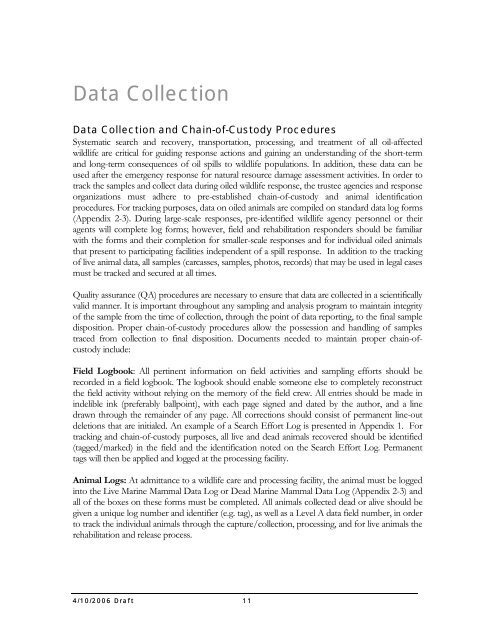Volume III, Appendices EM - National Marine Fisheries Service ...
Volume III, Appendices EM - National Marine Fisheries Service ...
Volume III, Appendices EM - National Marine Fisheries Service ...
Create successful ePaper yourself
Turn your PDF publications into a flip-book with our unique Google optimized e-Paper software.
Data Collection<br />
Data Collection and Chain-of-Custody Procedures<br />
Systematic search and recovery, transportation, processing, and treatment of all oil-affected<br />
wildlife are critical for guiding response actions and gaining an understanding of the short-term<br />
and long-term consequences of oil spills to wildlife populations. In addition, these data can be<br />
used after the emergency response for natural resource damage assessment activities. In order to<br />
track the samples and collect data during oiled wildlife response, the trustee agencies and response<br />
organizations must adhere to pre-established chain-of-custody and animal identification<br />
procedures. For tracking purposes, data on oiled animals are compiled on standard data log forms<br />
(Appendix 2-3). During large-scale responses, pre-identified wildlife agency personnel or their<br />
agents will complete log forms; however, field and rehabilitation responders should be familiar<br />
with the forms and their completion for smaller-scale responses and for individual oiled animals<br />
that present to participating facilities independent of a spill response. In addition to the tracking<br />
of live animal data, all samples (carcasses, samples, photos, records) that may be used in legal cases<br />
must be tracked and secured at all times.<br />
Quality assurance (QA) procedures are necessary to ensure that data are collected in a scientifically<br />
valid manner. It is important throughout any sampling and analysis program to maintain integrity<br />
of the sample from the time of collection, through the point of data reporting, to the final sample<br />
disposition. Proper chain-of-custody procedures allow the possession and handling of samples<br />
traced from collection to final disposition. Documents needed to maintain proper chain-ofcustody<br />
include:<br />
Field Logbook: All pertinent information on field activities and sampling efforts should be<br />
recorded in a field logbook. The logbook should enable someone else to completely reconstruct<br />
the field activity without relying on the memory of the field crew. All entries should be made in<br />
indelible ink (preferably ballpoint), with each page signed and dated by the author, and a line<br />
drawn through the remainder of any page. All corrections should consist of permanent line-out<br />
deletions that are initialed. An example of a Search Effort Log is presented in Appendix 1. For<br />
tracking and chain-of-custody purposes, all live and dead animals recovered should be identified<br />
(tagged/marked) in the field and the identification noted on the Search Effort Log. Permanent<br />
tags will then be applied and logged at the processing facility.<br />
Animal Logs: At admittance to a wildlife care and processing facility, the animal must be logged<br />
into the Live <strong>Marine</strong> Mammal Data Log or Dead <strong>Marine</strong> Mammal Data Log (Appendix 2-3) and<br />
all of the boxes on these forms must be completed. All animals collected dead or alive should be<br />
given a unique log number and identifier (e.g. tag), as well as a Level A data field number, in order<br />
to track the individual animals through the capture/collection, processing, and for live animals the<br />
rehabilitation and release process.<br />
4/10/2006 Draf t 11
















